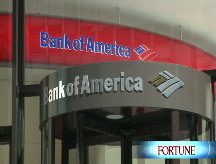U.K. unveils second bank rescue plan
British government launches wide scale insurance plan to protect banks against further losses and boost lending.
LONDON (CNNMoney.com) -- The U.K. government unveiled a second bank rescue plan Monday designed to jumpstart lending and bolster the stability of the nation's financial system.
The announcement made early Monday marks a dramatic new step for U.K. officials trying to contain a growing banking crisis. The announcement also comes as the U.S. government is poised to redirect its financial sector bailout efforts.
Under the plan, the British Treasury will set up a wide scale insurance program aimed at protecting banks against further losses and guarantee bank assets backed by mortgages and other loans.
"These are comprehensive measures focused on one purpose: increasing the amount of lending that is available to families and to the businesses who are the backbone of our country and who want to invest and create jobs," Prime Minister Gordon Brown said.
The mainstay of the new bailout is the insurance program, called the Asset Protection Scheme. Under this program, the Treasury will provide banks insurance against future credit losses on their riskiest assets.
U.K. financial institutions that take deposits and have more than £25 billion ($37 billion) of eligible assets will be the first banks to be considered for the insurance program. The scheme may also be extended to other deposit-takers later on, the Treasury said.
Banks will have to pay a fee to participate and will be subject to a range of conditions. For one, they will have to commit to lending to creditworthy consumers and businesses. Further details of the program are expected to be issued by the end of February.
The rescue package also calls for the Bank of England to set up a special fund that will be authorized to buy up to £50 billion ($74 billion) of high-quality private sector assets.
Shares in Europe advanced on the new bailout plan. In midday trading, Britain's FTSE 100 index rallied nearly 2%. France's CAC-40 and the DAX in Germany were both up more than 1%.
But Royal Bank of Scotland was a laggard after it warned Monday that it may have suffered the biggest loss in British corporate history -- as much as £28 billion ($41 billion) -- last year. Shares of Royal Bank of Scotland sank 32% in London trading.
U.S. markets are closed Monday for Martin Luther King Day.
The new measures unveiled by the U.K. mark the second attempt the government has made to stem the growing financial crisis.
Last October, the British Treasury pumped $63 billion into three major banks: the Royal Bank of Scotland, HBOS and Lloyds TSB. It also agreed to backstop bank debt.
The day after the U.K. bailout was announced, President Bush said he would use the first $250 billion of the $700 billion Troubled Asset Relief Program to make direct investments in banks.
Now, with President-elect Barack Obama set to take office Tuesday, the U.S. government is poised to take a new turn in its bank rescue effort. (Full story)
The Obama administration, which has $350 billion to work with after a Senate vote last week, has said it will take a different approach to TARP. For example, Lawrence Summers, a top economic aide to Obama, said in a letter to Congress last week that the administration would set aside as much as $100 billion to address mortgage crisis.
-- CNN Wires contributed to this report ![]()



